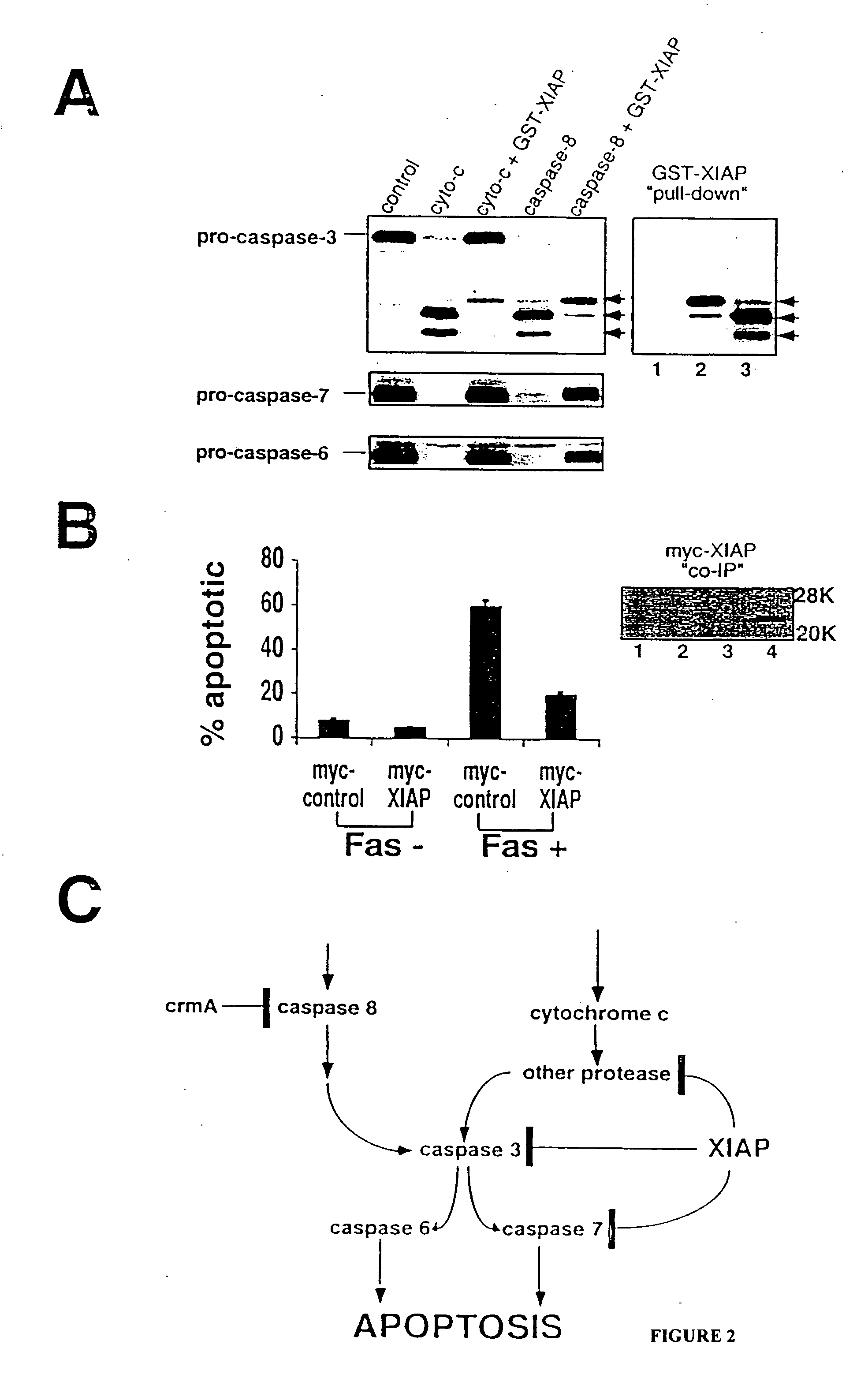Screening assays for agents that alter inhibitor of apoptosis (IAP) protein regulation of caspase activity
a technology of caspase activity and inhibitor, which is applied in the field of molecular medicine and drug screening assays, can solve the problems of defective regulation loss of function due to damaged nerve cells, complex process of programmed cell death regulation, etc., and achieves the effect of altering the caspase inhibitory activity of an iap, reducing the severity of a pathologic condition, and altering the level of apoptosis of the cell population
- Summary
- Abstract
- Description
- Claims
- Application Information
AI Technical Summary
Benefits of technology
Problems solved by technology
Method used
Image
Examples
example i
XIAP Inhibits Caspase Activity and Nuclear Degradation in a Cell-Free System
[0065] This example demonstrates that XIAP inhibits apoptotic-like destruction of isolated nuclei in cytosolic extracts and binds to and inhibits the activation of caspase-3 and caspase-7.
A. Plasmid Constructs:
[0066] A cDNA molecule encoding XIAP was obtained by RT-PCR using a first strand cDNA derived from Jurkat T cells as the template and specific primers based upon Genbank accession number U32974 (forward primer, 5′-GGGAATTCATGACTTTTAACAGTTTTGAAGGAT-3′ (SEQ ID NO: 4); reverse primer, 5′-CTCTCGAGCATGCCTACTATAGAGTTAGA-3′ (SEQ ID NO: 5)). The PCR product was digested with Eco RI and Xho I, then ligated into pcDNA3 (Invitrogen, Inc.; La Jolla Calif.), which contains an N-terminal Myc tag, or into pGEX4T-1 (Pharmacia; Piscataway N.J.), to produce pGEX4T-1-XIAP.
[0067] Plasmid pGEX4T-1-XIAP was introduced into E. coli strain BL21 (DE3) containing the plasmid, pT-Trx (Yamakawa et al., J. Biol. Chem. 270:253...
example ii
XIAP Selectively Inhibits the Activation of Caspase-3 and Caspase-7 and Binds to These Caspases
[0083] This example demonstrates that XIAP inhibits the activation of caspase-3 and caspase-7, but not of caspases-1, 6 or 8 and that XIAP specifically associates with caspase-3 and with caspase-7 in vitro.
[0084] Purified recombinant caspase-1, caspase-3, caspase-6, caspase-7 or caspase-8 were incubated with DEVD-pNA, either alone or with a 10-fold to 50-fold molar excess of GST-XIAP (20 μM) and substrate hydrolysis was measured. Purified active caspase concentrations ranged from 0.1 nM to 10 nM. XIAP concentration ranged from 0.1 nM to 500 nM. Assays were performed in caspase buffer (50 mM Tris, pH 7.4, 100 mM NaCl, 10% sucrose, 5-10 mM DTT, 1 mM EDTA and 0.1% CHAPS).
[0085] Purified GST-XIAP inhibited processing of DEVD-pNA in vitro by caspase-3 and by caspase-7 by greater than 95% when present at a 10-fold molar excess, but did not interfere with substrate cleavage by caspase-1, caspa...
example iii
XIAP Prevents Caspase Activation in Cells
[0091] This example demonstrates that XIAP inhibits Bax-induced caspase-3 processing and cell death in 293T cells, which are 293 cells that contain the SV40 large T antigen.
[0092] Subconfluent 293T cells were transfected with 1 μg pcDNA3-human Bax and either 9 μg pcDNA3 (control plasmid) or 9 μg pcDNA3-Myc-XIAP in 6 cm dishes using a calcium phosphate method. N-benzyloxycarbonyl-Val-Ala-Asp fluoromethylketone (zVAD-fmk; 50 μM) (Bachem California; Torrance Calif.) was added immediately after transfection of the Bax plasmid. Transfection efficiency was uniformly 80-90%, as determined by X-Gal staining following cotransfection with pCMV-βGal.
[0093] Cells were maintained in culture for 24 hr, then floating and attached cells were harvested and an aliquot was removed and the percent of dead cells was determined by either trypan blue or propidium iodide (PI) dye exclusion assay. A second aliquot was used to assess the percentage of apoptotic cel...
PUM
| Property | Measurement | Unit |
|---|---|---|
| molecular mass | aaaaa | aaaaa |
| pH | aaaaa | aaaaa |
| pH | aaaaa | aaaaa |
Abstract
Description
Claims
Application Information
 Login to View More
Login to View More - R&D
- Intellectual Property
- Life Sciences
- Materials
- Tech Scout
- Unparalleled Data Quality
- Higher Quality Content
- 60% Fewer Hallucinations
Browse by: Latest US Patents, China's latest patents, Technical Efficacy Thesaurus, Application Domain, Technology Topic, Popular Technical Reports.
© 2025 PatSnap. All rights reserved.Legal|Privacy policy|Modern Slavery Act Transparency Statement|Sitemap|About US| Contact US: help@patsnap.com



